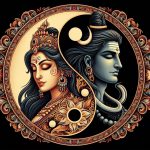In last blog, we explored the Mahavidyas—the great cosmic wisdoms representing dormant feminine energy. But have you ever wondered what lies beyond this? This time, let’s dive into something equally intriguing—Kundalini. You’ve probably come across countless articles about Kundalini online, but how many really make you question your understanding of self? My approach will offer a different perspective, one that might inspire you to begin your own journey.
A small disclaimer: If you are thinking, you will get superpowers like Shaktimaan by knowing Kundalini, this article is not for you.
Kundalini, like the Mahavidyas, represents dormant energy—the unawakened Shakti that lies within each of us which tries to fulfil itself through the reward circuitry in Brain. But what does it mean to have “dormant” unfulfilled energy within? And what happens if this energy awakens? Could this be the key to uncovering our true selves, hidden beneath layers of ego and identity?
When I refer to “divine feminine,” don’t get confused with “feminine” as a bodily characteristic. The divine feminine is an unfulfilled energy, and it resides within every individual, beyond gender. So, what does this energy look like?
Traditionally, Kundalini is imagined as a coiled serpent lying at the base of the spine, but let’s set the snake analogy aside for a moment. Think of Kundalini as “Aham”—the sense of self. Does that spark curiosity? Let’s see where this takes us.
General Disclaimer: The article has used FLUX Pro 1.1 and DALLE for image generation and GPT 4o for copyediting the text.
Table of Contents
Who Are You, Really?
Let’s start with a simple yet profound question: Who are you? Is your identity shaped by your achievements, your relationships, or your memories? Or is there something more?
“Aham” represents the essence of self—the “I” that exists in a state of incompleteness, always yearning for more, like the familiar feeling of “nothing is enough” or “Dil Maange More.”
When you say, “This is my Ph.D.” or “I am a doctor,” do you ever pause to consider: is it truly yours? You might argue, “I studied for it, I worked hard!” But think about it—who taught you? Who created the knowledge you absorbed? The books, the teachers, the resources—aren’t they integral parts of your achievement as well? Where, then, does the true “I” lie in all of this?
Now, reflect on this: are you the one savoring the beauty of a flower or something which you like, or is it simply a reaction in your brain?
Neuroscience tells us that sensory neurons create these perceptions, but is that enough to define who you are? Are we merely our minds, or is there something beyond?
The Journey Through the Chakras.
As per the Tantric Philosophy Kundalini, as it moves, encounters seven centers of existence within us, each revealing a different layer of incomplete “Aham.”
Have you ever noticed that, as you grow, your desires and perceptions shift, too?
Here, each chakra is like a different lens on life, and awakening Kundalini is, in part, about moving through these lenses—shedding the old, awakening the new.
Muladhara Chakra: Who Are You at the Root?
This is where it all begins. The Muladhara, or root chakra, is the anchor of your identity. Society assigns you a name, nature attaches a gender to it, and with these labels, your journey of self-definition begins. But have you ever wondered if you are simply your name or gender? Is this truly you, or just a foundational layer striving to feel complete?
For instance, as a man or woman, you may find yourself seeking a compatible partner. With a name tied to your identity, you might pursue success, status, and achievements in your career. But is that all there is to you?
The Muladhara is intimately connected with our breath, and through practicing breath awareness, you can start to sense this chakra. It’s the foundation—a starting point for all of us. To explore this further, you might consider practicing Kriya to deepen your awareness of the Muladhara. Explaining Kriya fully would take us beyond the scope of this piece, but it’s a topic we can explore in future articles. For now, let’s dive into the other chakras and what they reveal about our journey.
Svadhisthana Chakra: What Desires Do You Carry?
Moving upwards, we encounter the Svadhisthana, the seat of desire. Now ask yourself, what desires dwell within you? Why do they arise? Isn’t it true that desires often stem from a sense of incompleteness?
Think back—have you ever wanted something simply because you were told you couldn’t have it? Perhaps it was a favorite ice cream denied in childhood. But is that the whole story? If every desire arises from a sense of lack, can desires ever truly be satisfied?
The Svadhisthana holds not only your current desires but, some believe, even those from past lives. As Kundalini rises here, desires can either propel you forward or consume you entirely. It’s a pivotal point; a balanced Kundalini can make one a Ram, while an imbalanced one here could lead to a Ravana-like descent.
So here’s a question to ponder: are your desires guiding you, or are they controlling you? Think about Ram and Ravana—two figures shaped by their desires—to gain clarity on this.
Mysteriously Ram itself is the mantra that establishes you above your desires. Here is an article from Yogapedia related to it.
Manipura Chakra: What Does Fulfillment Feel Like?
When desires are truly understood and transformed, they ascend to the Manipura—the chakra of fulfillment, often called the “city of jewels.” Located at the solar plexus, this energy center represents our personal power, confidence, and will. Here, desires change; they become more refined, moving from a drive to satisfy basic needs to an inner strength that fuels our ambitions and sense of purpose.
But here’s a thought: does achieving personal goals really bring lasting fulfillment?
Think of a time when you accomplished something significant. Maybe it was a career milestone, or perhaps something deeply personal. Did you feel complete, or did a new longing arise soon after? Manipura raises these kinds of questions. Fulfillment here may seem tied to outward success, yet a deeper realization begins to take shape.
We start asking ourselves, What does it mean to feel truly fulfilled?
In this chakra, our definition of fulfillment shifts. We begin to sense that real fulfillment isn’t found in material achievements alone. It’s about recognizing that our personal power can be directed not just for self-gain but as a force for something larger—a purpose that extends beyond ourselves. This is where the energy of fulfillment turns toward divine love, a love that connects us to a deeper, more selfless sense of purpose.
Anahata Chakra: Is Your Love Pure?
As Kundalini rises further, it reaches the Anahata, the heart chakra—the place where love unfolds beyond personal relationships, growing into an expansive love for all beings. But here lies a challenge: Can this love remain pure? Can it exist without attachment, ego, or expectation? Loving someone who loves you back is easy, but what about loving without the need for anything in return? Is it even possible?
Have you felt this level of love, one that doesn’t seek to possess, control, or validate itself? Anahata invites you to turn this love inward, not outward in search of something but toward a higher truth or the Shiva. Imagine if love didn’t need reciprocation to thrive—if it could just be. How might this transform you?
And as the energy continues upward, love moves from feeling to expression. This brings us to Vishuddhi, the throat chakra, where love is voiced with clarity and wisdom. Here, it gains the power of words, tarka (reasoning), and knowledge woven with love (philosophy). The journey from Anahata to Vishuddhi transforms love into a truth that flows through expression which deepens our understanding of the self and the universe around us.

Vishuddhi Chakra: Can You Purify Your Voice and Thoughts?
The Vishuddhi chakra, also known as the throat chakra, represents the center of purity, clarity, and truthful expression. Located at the throat, Vishuddhi governs how we communicate, listen, and express ourselves. It’s not merely about speaking but about speaking with awareness, honesty, and integrity. Here, we begin to notice the power of our words and thoughts—Are they truthful? Are they aligned with our higher self, or do they spring from ego and attachment?
Vishuddhi is where Matrikas, or primordial sound energies, are said to reside. Each sound or vibration carries a unique energy, shaping our experiences and influencing others. In this chakra, sound isn’t merely a means of communication but a tool for manifesting reality. Have you ever considered the power of a single word? Words can inspire, heal, or even cause harm. When we speak carelessly, we scatter our energy; when we speak with clarity, we harness it. Vishuddhi invites us to look inward and ask, How often do I speak without thinking? Are my words a reflection of my inner truth, or do they mask it?
Consider this: Vishuddhi challenges us to purify our words, not just in conversations with others but in the dialogue we have with ourselves. Are we critical or kind in self-talk? Do we reinforce limiting beliefs, or do we speak words of growth? Each thought and word is a vibration that resonates beyond the body, affecting our own consciousness and that of others. Vishuddhi is about aligning our voice with our true self, learning to filter what’s unnecessary, and recognizing the impact of every sound we produce.
Ajna Chakra: What Lies Beyond Duality?
As Kundalini ascends to the Ajna, or third eye chakra, a profound shift in perception occurs. This chakra, nestled between the eyebrows, is where the veil of duality begins to thin. It allows us to see beyond the illusions of “good” and “bad,” “success” and “failure,” or “self” and “other.”
But here’s a question: Is it truly possible to rise above these concepts that are so deeply woven into our lives? Could you look at the world without the urge to categorize everything? The Ajna challenges us to recognize that these binaries are constructs that limit our understanding.
At this level, we begin to see that opposites are simply different expressions of the same essence. Have you ever noticed how fear and love are intertwined? They both emerge from the same well of emotion, yet we often choose to view them as separate.
As we explore the Ajna, we start to understand life as a continuous loop of cause and effect, shaped by our thoughts and actions—a dynamic often referred to as the reward circuitry, or Manas. Have you observed how your thoughts influence your reality?
This awareness at the Ajna empowers us to break free from reactive patterns and encourages a more conscious approach to life. It invites us to embrace the full spectrum of our experiences, setting the stage for our final ascent to the Sahasrara chakra, where we unite all these insights into a state of pure awareness. Here, we discover that our journey through duality is not about choosing sides but about realizing our interconnectedness in the cosmic dance of existence.
Sahasrara Chakra: What Does Ultimate Union Feel Like?
At the Sahasrara—the crown chakra—Shakti merges with Shiva, creating a profound awareness of the entire reward circuitry within. Have you ever pondered what lies beyond all desires? Here, the Sahasrara symbolizes the peak of fulfillment, achieved not through fleeting rewards but through a singular focus: the union of Kundalini (Shakti) with the cosmic consciousness (Shiva).
In this state, the essence of the reward circuitry transforms into a unified experience. The Sahasrara encourages you to redirect your attention toward one ultimate desire—the connection with the absolute. When Kundalini reaches this chakra, countless impulses for reward coalesce into a single aspiration: the longing for completeness and dissolution into the universal which is achieved in the Bindu Chakra which is sometimes called as 8th Chakra also.
Have you noticed how, in moments of deep meditation, your awareness can shift from self-centered desires to a broader sense of well-being? Research shows that when we focus beyond ourselves, our brain’s reward system reorients, calming the default mode network (DMN)—the part of our mind that loops through self-referential thoughts. In this quiet space, individual cravings fade, replaced by a sense of boundless contentment.
In this final stage, the Kundalini becomes one with Shiva, representing a consciousness that transcends personal desires, leading to a deep, transcendental satisfaction. The Sahasrara isn’t just the conclusion of a journey; it’s the realization of wholeness—the return of the self to the cosmic self. Have you felt moments where the boundaries of your individual self dissolve, merging into something greater? This is the essence of Sahasrara, where we awaken to an eternal unity that connects us all.




